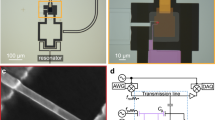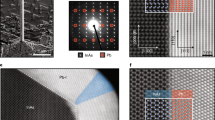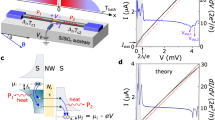Abstract
The controlled growth of nanowires (NWs) with dimensions comparable to the Fermi wavelengths of the charge carriers allows fundamental investigations of quantum confinement phenomena. Here, we present studies of proximity-induced superconductivity in undoped Ge/Si core/shell NW heterostructures contacted by superconducting leads. By using a top gate electrode to modulate the carrier density in the NW, the critical supercurrent can be tuned from zero to greater than 100 nA. Furthermore, discrete sub-bands form in the NW due to confinement in the radial direction, which results in stepwise increases in the critical current as a function of gate voltage. Transport measurements on these superconductor–NW–superconductor devices reveal high-order (n = 25) resonant multiple Andreev reflections, indicating that the NW channel is smooth and the charge transport is highly coherent. The ability to create and control coherent superconducting ordered states in semiconductor–superconductor hybrid nanostructures allows for new opportunities in the study of fundamental low-dimensional superconductivity.
This is a preview of subscription content, access via your institution
Access options
Subscribe to this journal
Receive 12 print issues and online access
$259.00 per year
only $21.58 per issue
Buy this article
- Purchase on Springer Link
- Instant access to full article PDF
Prices may be subject to local taxes which are calculated during checkout




Similar content being viewed by others
References
Tinkham, M. Introduction to Superconductivity (Dover, New York, 1996).
Likharev, K. K. Superconducting weak links. Rev. Mod. Phys. 51, 101–159 (1979).
Van Wees, B. J. et al. Quantized conductance of point contacts in a two-dimensional electron-gas. Phys. Rev. Lett. 60, 848–850 (1988).
Beenakker, C. W. J. & Van Houten, H. Josephson current through a superconducting quantum point contact shorter than the coherence length. Phys. Rev. Lett. 66, 3056–3059 (1991).
Klapwijk, T. M. Proximity effect from an Andreev perspective. J. Supercond. 17, 593–611 (2004).
Takayanagi, H., Akazaki, T. & Nitta, J. Observation of maximum supercurrent quantization in a superconducting quantum point-contact. Phys. Rev. Lett. 75, 3533–3536 (1995).
Bauch, T. et al. Correlated quantization of supercurrent and conductance in a superconducting quantum point contact. Phys. Rev. B 71, 174502 (2005).
Muller, C. J., Vanruitenbeek, J. M. & DeJongh, L. J. Conductance and supercurrent discontinuities in atomic-scale metallic constrictions of variable width. Phys. Rev. Lett. 69, 140–143 (1992).
Lieber, C. M. Nanoscale science and technology: Building a big future from small things. MRS Bulletin 28, 486–491 (2003).
Samuelson, L. Self-forming nanoscale devices. Mater. Today 6, 22–31 (2003).
Zhong, Z. H., Fang, Y., Lu, W. & Lieber, C. M. Coherent single charge transport in molecular-scale silicon nanowires. Nano Lett. 5, 1143–1146 (2005).
De Franceschi, S. et al. Single-electron tunneling in InP nanowires. Appl. Phys. Lett. 83, 344–346 (2003).
Bjork, M. T. et al. Few-electron quantum dots in nanowires. Nano Lett. 4, 1621–1625 (2004).
Lu, W., Xiang, J., Timko, B. P., Wu, Y. & Lieber, C. M. One-dimensional hole gas in germanium/silicon nanowire heterostructures. Proc. Natl Acad. Sci. USA 102, 10046–10051 (2005).
Xiang, J. et al. Ge/Si nanowire heterostructures as high-performance field-effect transistors. Nature 441, 489–493 (2006).
Doh, Y. J. et al. Tunable supercurrent through semiconductor nanowires. Science 309, 272–275 (2005).
Van Dam, J. A., Nazarov, Y. V., Bakkers, E. P. A. M., De Franceschi, S. & Kouwenhoven, L. P. Supercurrent reversal in quantum dots. Nature 442, 667–670 (2006).
Andreev, A. F. The thermal conductivity of the intermediate state in superconductors. Sov. Phys. JETP 19, 1228–1231 (1964).
Octavio, M., Tinkham, M., Blonder, G. E. & Klapwijk, T. M. Subharmonic energy-gap structure in superconducting constrictions. Phys. Rev. B 27, 6739–6746 (1983).
Lauhon, L. J., Gudiksen, M. S., Wang, C. L. & Lieber, C. M. Epitaxial core–shell and core–multishell nanowire heterostructures. Nature 420, 57–61 (2002).
Van Wees, B. J. et al. Quantum ballistic and adiabatic electron-transport studied with quantum point contacts. Phys. Rev. B 43, 12431–12453 (1991).
Topinka, M. A. et al. Imaging coherent electron flow from a quantum point contact. Science 289, 2323–2326 (2000).
Cronenwett, S. M. et al. Low-temperature fate of the 0.7 structure in a point contact: A Kondo-like correlated state in an open system. Phys. Rev. Lett. 88, 226805 (2002).
Kristensen, A. et al. Bias and temperature dependence of the 0.7 conductance anomaly in quantum point contacts. Phys. Rev. B 62, 10950–10957 (2000).
Tinkham, M., Free, J. U., Lau, C. N. & Markovic, N. Hysteretic I–V curves of superconducting nanowires. Phys. Rev. B 68, 134515 (2003).
Octavio, M., Skocpol, W. J. & Tinkham, M. Improved performance of tin variable-thickness superconducting microbridges. IEEE Trans Magn. 13, 739–742 (1977).
Jarillo-Herrero, P., van Dam, J. A. & Kouwenhoven, L. P. Quantum supercurrent transistors in carbon nanotubes. Nature 439, 953–956 (2006).
Buitelaar, M. R. et al. Multiple Andreev reflections in a carbon nanotube quantum dot. Phys. Rev. Lett. 91, 057005 (2003).
Blonder, G. E., Tinkham, M. & Klapwijk, T. M. Transition from metallic to tunneling regimes in superconducting micro-constrictions — Excess current, charge imbalance, and super-current conversion. Phys. Rev. B 25, 4515–4532 (1982).
Flensberg, K., Hansen, J. B. & Octavio, M. Subharmonic energy-gap structure in superconducting weak links. Phys. Rev. B 38, 8707–8711 (1988).
Acknowledgements
We thank Y.J. Doh and J.U. Free for helpful discussions. M.T. acknowledges support from the National Science Foundation. R.M.W. acknowledges support of this work by DARPA-QuIST and the Nanoscale Science and Engineering Center at Harvard University. C.M.L. acknowledges support of this work by the Defense Advanced Research Projects Agency, Army Research Organization and NSF.
Author information
Authors and Affiliations
Contributions
J.X. and A.V. performed the experiments and analysed the data with help from M.T. All the authors discussed the results and co-wrote the manuscript.
Corresponding authors
Ethics declarations
Competing interests
The authors declare no competing financial interests.
Supplementary information
Rights and permissions
About this article
Cite this article
Xiang, J., Vidan, A., Tinkham, M. et al. Ge/Si nanowire mesoscopic Josephson junctions. Nature Nanotech 1, 208–213 (2006). https://doi.org/10.1038/nnano.2006.140
Received:
Accepted:
Published:
Issue Date:
DOI: https://doi.org/10.1038/nnano.2006.140
This article is cited by
-
Parity-conserving Cooper-pair transport and ideal superconducting diode in planar germanium
Nature Communications (2024)
-
Quantifying quantum coherence of multiple-charge states in tunable Josephson junctions
npj Quantum Information (2024)
-
Cryogenic multiplexing using selective area grown nanowires
Nature Communications (2023)
-
Hole-type superconducting gatemon qubit based on Ge/Si core/shell nanowires
npj Quantum Information (2023)
-
Magnetic field enhanced critical current and subharmonic structures in dissipative superconducting gold nanowires
Quantum Frontiers (2022)



